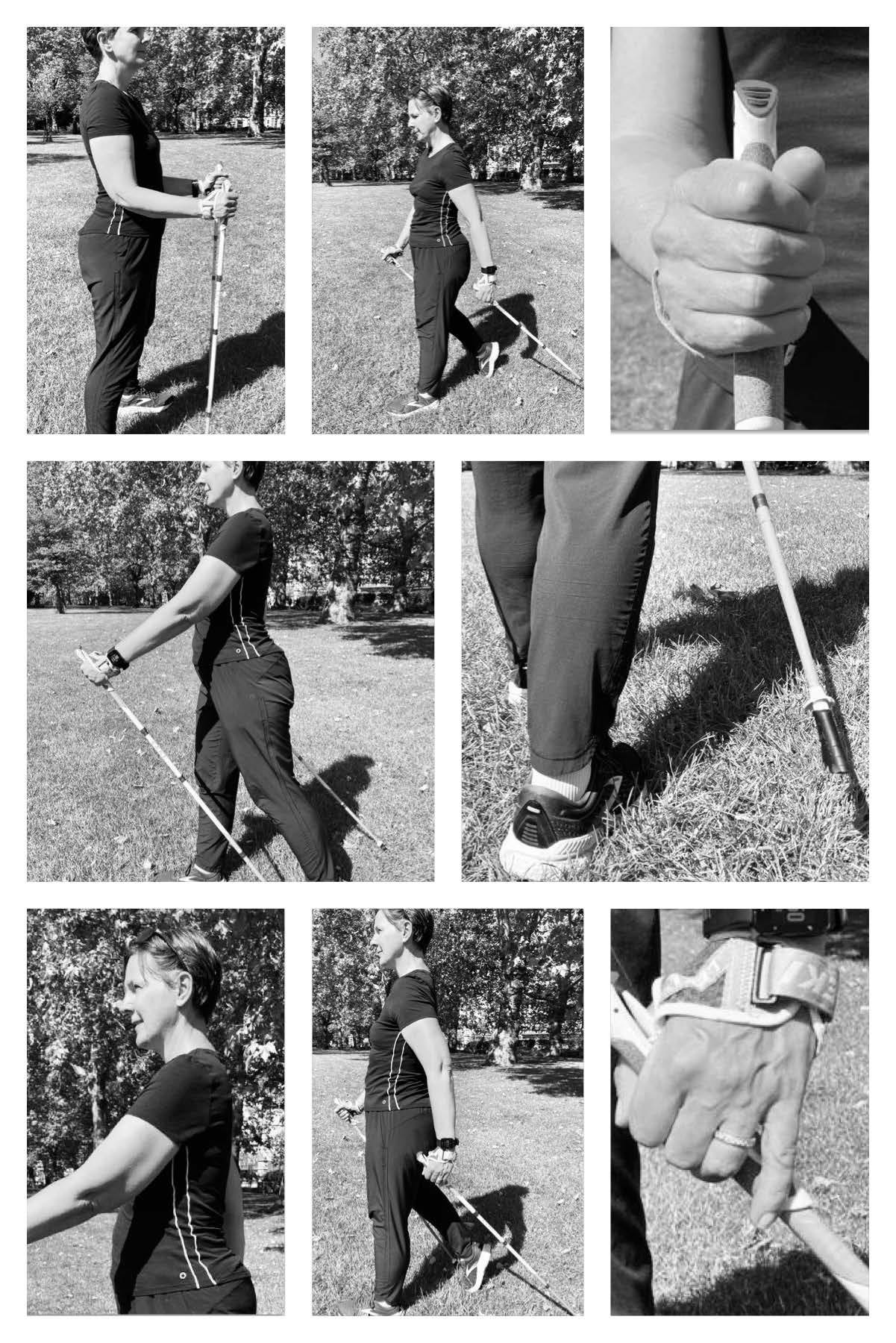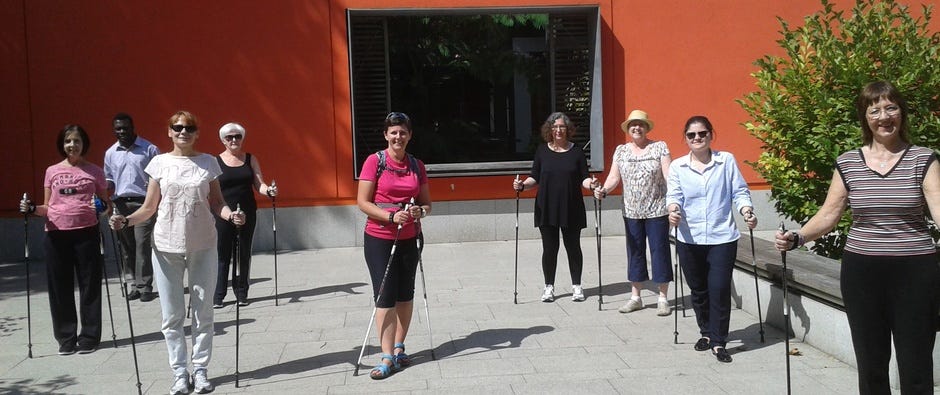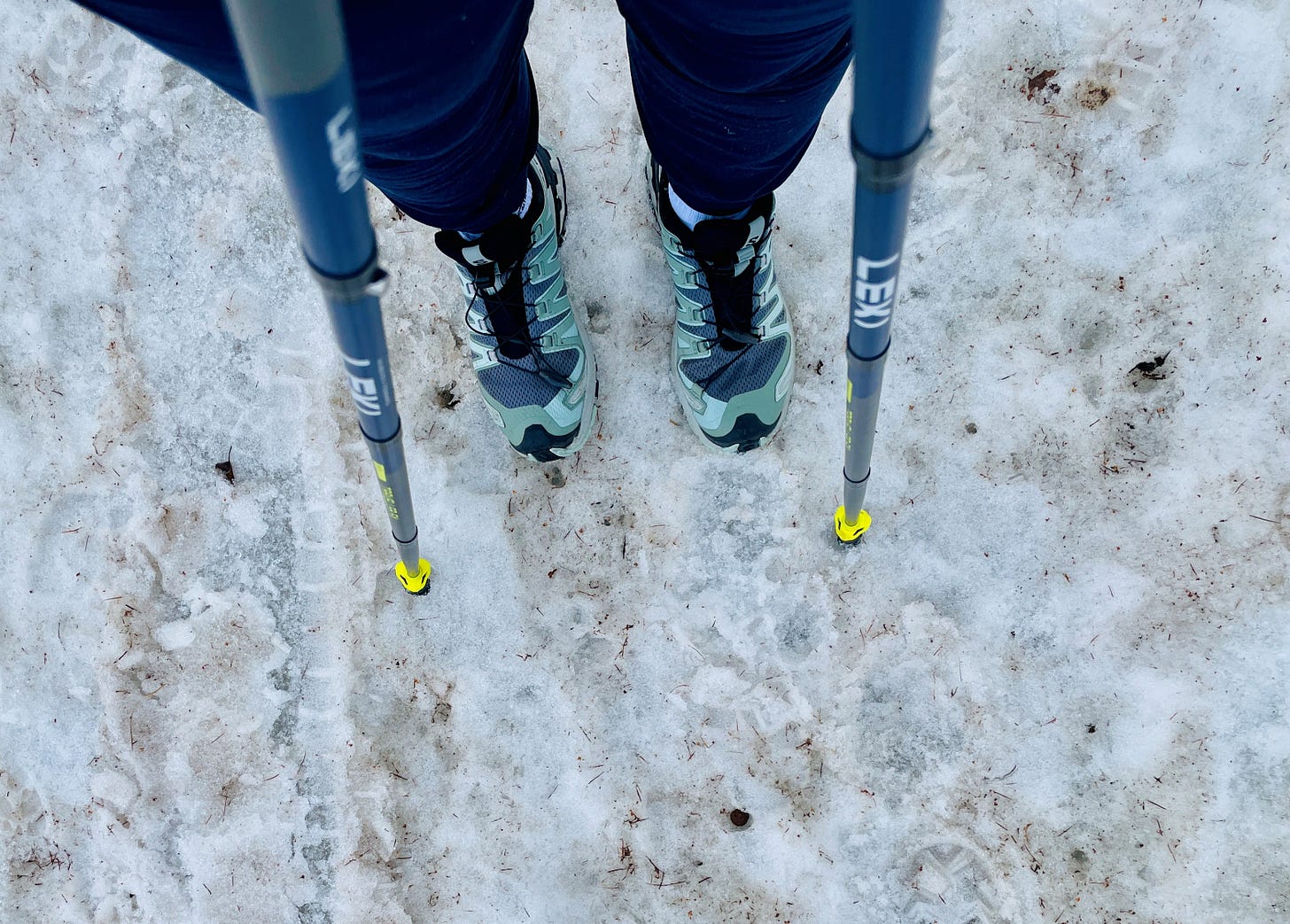I’ve been teaching Nordic walking, and loving doing it, for all of the time I’ve been a cancer exercise specialist. In 2013 I went to a conference about exercise and got chatting to the trailblazing Gill Stewart1 and I’ll never forgot the thing she said when I told her my plans for oomph: ‘You do realise that Nordic walking is perfect for your client group, don’t you?’. I hadn’t, but I have been an avid Nordic walker ever since that conversation.
Why Nordic walking + cancer?
I’ve written much about the benefits of Nordic walking for the cancer community since that day and have taught it through the Maggies Cancer Support Centres for more than a decade. If you haven’t come across it before, have a read here - it’s a blog post I wrote a while ago and that became part of the chapter on Nordic walking in my book.2
Nordic walking is fabulous exercise for the cardiovascular system. The poles can help anyone experiencing fatigue to feel a little more supported, and they help us to stand tall, breathe deeply and to feel we can tackle hills and longer distances, because the poles give us added momentum. It is a weight bearing activity, so helps us all to preserve our bone mineral density and has been shown to help strengthen the bones in the lower arms as well as in the lower body.
The poles are fab for men who’ve had treatment for prostate cancer as they are supportive for muscles that aren’t as strong as they were, and they use movement that’s sympathetic to the pelvic floor (IYKYK). The poles also help anyone whose balance is off kilter thanks to the drugs, and they give the brain information about the terrain we’re walking on which can be really reassuring for those with peripheral neuropathy in the feet from chemo.
Nordic walking is proven to help offset many of the side effects from breast cancer treatment, particularly around strength and range of motion in the shoulders and in supporting lymphatic drainage that is so often a consequent of lymph node surgery. I used my poles as I was recovering from my mastectomy and they were so, so helpful. They allowed me to feel like I was doing something for myself, for my mind and for my own healing.
And on that note, they get us outdoors, into nature, with all the benefits to mood and mind that go with that.
Why Nordic walking + menopause?
Which leads me to menopause. Many of us gain weight and see an increase in body fat. For some it can happen when ‘crash menopause’ comes on very quickly as a result of treatment. For others it’s a long-drawn out process. According to the British Menopause Society we, on average, gain 10kg over the course of the time from peri- to post- menopause3.
Ever since I began taking tamoxifen I’ve gained weight, and I’m typical in that it’s mostly on my tummy. Over the course of five years of cancer and menopause I have become the owner of a generous 10 lbs, perhaps more, of recently-acquired body fat.
To be absolutely truthful it is one of the impacts of the cancer/menopause chaos that I think bothers me most. More than the hot flushes, more than only having one breast. My clothes don’t fit, I feel heavy, and I know that, despite living a healthier lifestyle than I did pre-cancer, I’m still gaining fat, especially on my abdomen, and that can be a pre-cursor for all sorts of health issues in the future.
What I’m only recently starting to understand, is why – and in particular why I started to gain abdominal fat even though I was training for a marathon, whilst doing my job full time.
Now – importantly – I really, really hope that this doesn’t sound like shallow vanity, or body shaming/self-shaming. I am truly not yet another voice from the fitness industry berating women for putting on weight. Weight gain during menopause is an entirely natural aspect of an entirely natural period of transition.
Something I’ve read many times is that our bodies are different once we hit the menopause years, and that, if we wish to alter our bodyweight, we need to do it differently to before. What might have worked for us in the past may not work now. I’ve been trying to get my head around what is best for me to do, and how best I could start to burn fat, and one message I come across frequently is about the need to manage the stress hormone cortisol.
Why Menopause + cortisol?
Because excess cortisol stimulates glucose production, so that, in an entirely evolutionary reaction, we would have the energy to run away from a threat. This excess glucose, if not used to leg it, is then typically converted into fat, which gets stored in the body. With cortisol, it's stored as abdominal fat (sometimes called central adiposity)4.
Menopause changes our bodies in lots of ways, one of which is our relationship with cortisol. As our oestrogen levels drop, our cortisol can rise more readily, hence one of the factors in why we can feel stressed or anxious more often. Gosh isn’t menopause a gift that keeps on giving?
We generate cortisol in many situations, including during physical activity because pushing ourselves physically triggers that internal ‘fight or flight’ response. I believe this is one reason why I’ve gained weight despite my active job and lifestyle: I am, unwittingly, over training and putting my body under sufficient stress to cause it to produce way more cortisol than my system can cope with, so my body is storing it as fat, on my tum.
Burning fat while keeping cortisol under control
I started to think very specifically about how I might want to exercise differently now, because I want to lose some of that body fat but to do it in a way I’ll find joyful and in a way that will help me to contain my levels of cortisol. Despite years of loving running, I had a bit of a lightbulb moment, and decided to look into whether using my trusty poles might be a smarter option, for me, for now.
It turns out that Nordic walking – which is considered a ‘moderate’ form of exercise, might be just the thing. It’s less stress on the body than higher impact activities and therefore is going to be calmer on the hormonal system. It’s more comfortable than running and other forms of higher impact exercise can be. I find Nordic walking in my own company to be really relaxing. There’s a therapeutic rhythm between my feet and the poles and it can feel meditative, especially when I’m somewhere beautiful.
Nordic walking is often touted as one way of exercising in order to lose weight: it burns more calories per hour than regular walking (between 20 and 46% more, depending on who you ask). The better your technique, the more muscles are used and therefore more calories burned.
How I started
I first picked up my poles with an intention to find a classic ‘fat burning zone’ on holiday in Switzerland, in mountains. Note: there are numerous opinions and interpretations of what it takes for our bodies to burn fat during exercise. If you’re interested, read this as a starting point.
For my interpretation, I stuck with what is traditional thought, all be it possibly a bit simplistic. I tracked my heart rate, hoping to keep it within 60-70% of its maximum, (220 minus my age (56). So, for me, 98-115 beats per minute).
I set out to walk for an hour at that intensity as I had read that when we exercise for longer than an hour our cortisol levels rise5. I found that in order to keep my heart rate about 100bpm I needed to walk briskly, with a proper spring in my step. If I swung my arms fully, so my fists came right back to my hip each step, then I’d hit 105 and above and if I powered up any incline at all then my heart rate went up accordingly but stayed within the range I was hoping for. This was exercise at a level that I could sustain, that felt really enjoyable, and that wasn’t too much (which it turns out is really important for managing cortisol). And it felt good.
Building Nordic walking into a menopause-supporting exercise plan
So, how might we incorporate nordic walking into our lives, into our plans for wellbeing and without adding to the never-ending to-do list? I think the simplest thing would be to swap some of the cardio exercise we are doing and go Nordic walking instead and see how it feels. I usually go for a run either at the weekend or on the day midweek that I don’t see clients: I could do an hour or so of brisk Nordic walking instead, once or twice a week.
Regardless of cancer and menopause, the same guidelines apply to me as they do to you and to the wider adult population: our bodies benefit from 150 minutes of cardiovascular exercise each week6. I still want to retain some higher impact activity both for myself and my clients so my thinking is to also use a skipping rope in short bursts on the days I/we do strength training. If I was helping you to devise an exercise plan I’d then add in any sport of physical activity that you love just for the joy of it, to get you up to the150 minutes each week, plus some good stretching/ flexibility. For me, that’d be yoga practice, but some tai chi, qi Gong or gentle Pilates would work well.
But make it calm, so that it feels nurturing. Make it something you love, or can learn to love, so that we take as much of the stress away as we can.
My book ‘Get your oomph back – a guide to exercise after a cancer diagnosis’ can be purchased here7. Chapter 3 has information about Nordic walking and chapter 4 has a step-by-step guide to technique.
Gill’s book ‘The Complete Guide to Nordic walking’ is widely available
British Menopause Society, Menopause: Nutrition and Weight Gain. Access it here
https://www.verywellhealth.com/the-cortisol-weight-loss-controversy-3233036
https://www.flippingfifty.com/fat-burning-in-menopause
World Health Organisation guidelines on physical activity for adults
Get your oomph back. A guide to exercise after a cancer diagnosis. By me.







A very interesting and thought provoking read ♥️
V interesting!